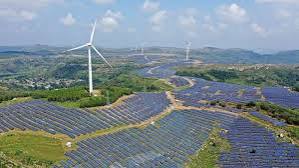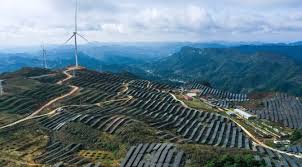Combined, the amount of wind and solar power capacity under construction in China has more than doubled the amount under construction in the rest of the world, making china to lead global wind and solar projects according to a new report. An analysis released by Global Energy Monitor(GEM), an NGO, revealed that China recorded 180GW of utility scale solar projects under construction while 159GW for wind power.
Total capacity
The total installed capacities of wind and solar power under construction globally has crossed 339GW, which is significantly higher than the 40GW of capacities under construction in the US. The researchers narrowed the pool of analysis to include only stations of 20MW and above connected directly to the grid. It comes down to the fact that the overall capacity of China solar power could be much bigger, since small scale solar fields comprise for around 40% of Chinese solar potential.

The latest statistics showed China remained a global leader in renewable energy generated at a time when the US is growing more concerned over Chinese overcapacity and dumping of solar panels. China has also recently witnessed a steep rise in the installation of renewable energy where the support from the government has been immense.
China’s president XI Jinping emphasised the need for new, qualitative types of productive forces, which means that China wants to shift from being a country relying on traditional industries to a country focused on technology. Xi has defined “new quality productive forces” as the improvement of green manufacturing. Solar installations in China tripled in the fourth quarter of 2023 compared to the same period in 2022, and more than the rest of the world combined for 2023, according to GEM analysts. The combined wind and solar capacity of China is expected to hit 1,200GW by the end of 2024 despite the government’s forecast of 2025.
Scope
Global Energy Monitor have recently pointed out that even more of renewable capacity will be required in the country if China has to meet its commitments of reducing the carbon intensity of the economy by 18%, which is a significant component of the emission reduction target. Carbon intensity is defined as how many grams of CO2 are emitted for one kilowatt hour of electricity.

Previous studies indicate that to attain the goal of securing 25 per cent of all energy from sources other than fossils by 2030, China will have to integrate between 1,600GW and 1,800GW of wind and solar energy. In 2020-2023, the share of renewables to meet the increase in energy consumption amounted to 30%, while the indicator was at 50%. “It is of course crucial that China continues to ramp up its renewable energy generation in order to hit the targets,” Li Shuo of the China Climate Hub at the Asia Policy Institute in Washington D. C. “It is not like you just keep building and it will be solved … [because] there is no indication that the country is attempting to decrease its use of coal.
Earlier this year, GEM and the Centre for Research on Energy and Clean Air (CREA), a think tank, calculated that approvals of new coal power plants rose fourfold in 2022-2023, compared with the 2016-2020 period, contrary to a pledge made in 2021 to “strictly control” new coal power. The average annual growth rates in total coal consumption were 0. From 5% per annum to 3. From one period to the other, inflation rose to 8% per annum.
Also Read: Why Battery Storage is Becoming Essential for Solar and Wind Projects
Challenges
Chinese power grid is still heavily dependent on coal, which the officials consider necessary due to the variability of renewable energy sources. And officials often view coals as a way to stimulate local gross domestic product, even as clean energy industries are now the fastest-growing part of China’s economy, contributing to 40% of GDP increases in 2023. Experts argue that with more volume of clean energy being developed at China’s wind and solar firms, there is need for enhanced storage and grid flexibility. The Chinese government is aware of this challenge, referring to lithium-ion batteries as one of the ‘new three,’ like electrified vehicles and solar power. In the year 2022, $11bn was invested in grid-connected batteries, which was up from $2. 4bn in the year 2022.
According to the GEM report, China also leads in the implementation of planned renewable energy infrastructure. The current capacity of wind and solar projects under construction stands at 339GW, which is one-third of proposed projects, significantly ahead of the global construction ratio of 7%. “China’s pipeline of renewable energy projects is two times bigger than the rest of the world,” Li said. “But the question we should increasingly ask ourselves is, how come the rest of the world is so slow?”
Read also The North-South Expressway in Vietnam Begins Final Link to China
Read also World’s largest solar farm, 3.5 GW, connected to grid, China

